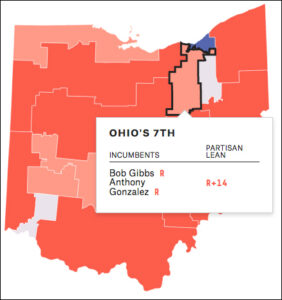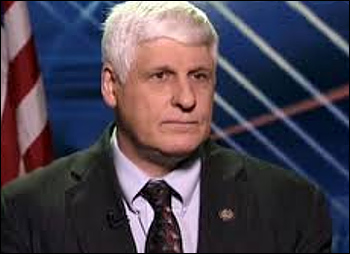By Jim Ellis
April 8, 2022 — Expressing frustration with the Ohio courts and constituent complexion of his new district, six-term Buckeye State Rep. Bob Gibbs (R-Lakeville) on Wednesday surprisingly became the 22nd Republican US House member who has decided not to seek re-election.This retirement announcement is different from all the others — 31 Democrats have also made public their decision to leave the House at the end of the current session — because Gibbs had filed for re-election and Ohio early voting has already begun.
Lashing out at the state Supreme Court that has delayed for weeks in providing 2022 candidates a clear direction with regard to the redistricting maps, Gibbs said in his retirement announcement statement, “It is irresponsible to effectively confirm the congressional map for this election cycle seven days before voting begins, especially in the Seventh Congressional District, where almost 90 percent of the electorate is new and nearly two-thirds is an area primarily from another district, foreign to any expectations or connection to the current Seventh District.”
Rep. Gibbs has a valid point about the state Supreme Court. After rejecting the original congressional map under partisan gerrymandering reasoning, the legislature returned a second map, and the court did not render a decision, even after again rejecting the alternative version maps for the state House and Senate. Therefore, the congressional incumbents and candidates have been languishing for weeks not knowing precisely the location of the new district lines, and long past the candidate filing deadline that occurred on March 4.
The court justices then informed the Democratic plaintiffs regarding their lawsuit challenging the congressional lines, after waiting for several weeks with no action, that the original decision on the first map constituted their final ruling, thus the plaintiffs would have to file a new lawsuit for them to consider further arguments to the second plan. The Democratic plaintiffs did file again, but even preliminary action of any kind is reportedly now months away. Hence, the second map is, at least for now, in place for the 2022 election cycle.
The court and legislature were also in a battle over whether the high court even has jurisdiction to order new maps. Under the Ohio Constitution, the courts do not have authority to draw new redistricting maps. They may only remand any rejected map back to the legislature. Thus, the continuing saga of 2022 Ohio redistricting.
Considering Gibbs’ late withdrawal, Secretary of State Frank LaRose (R) immediately announced that the congressman’s name cannot be removed from the ballot, and any vote cast for him would now not be counted. The move puts former Trump White House aide and Marine Corps veteran Max Miller in the favorite’s position for the Republican primary.
Aside from Miller, the Republican field is weak, obviously because Gibbs was running. The remaining qualified Republicans in addition to Miller are financial executive Charlie Gaddis, computer technician Brandon Lape, and non-profit group founder Jonah Schulz. Miller is the clear fundraising leader at $1.8 million raised at the end of 2021, with just under $1 million in his campaign account. Under the original redistricting map, Miller was running in open District 13.

Ohio’s 7th CD (Click on map or here to go to FiveThirtyEight’s interactive map)
Gibbs is also correct that 90 percent of the new 7th District does not come from the current CD-7. In fact, two-thirds, or more accurately 64.9 percent of the new draw, comes from retiring Rep. Anthony Gonzalez’s 16th CD, the seat that was collapsed because Ohio lost a seat in national reapportionment. In this second map, Rep. Gibbs’ current 7th is dispersed into six different districts.
The current OH-7 begins in the Canton area and sweeps south and west into central Ohio. It then juts north into the Cleveland suburban area annexing places such as the cities of Wooster and Ashland, before traveling almost to Lake Erie, ending just north of the town of Avon.
The new 7th begins in the western Cleveland suburbs and runs due south to pick up the cities of Medina, Wadsworth, and Westwood, among others. This second OH-7 version rates a relatively strong R+14 according to the FiveThirtyEight data organization. Dave’s Redistricting App, the other data entity that scores all of the new districts rates the average Republican percentage at 53.6, with the Democrats typically scoring in the 44.1 percent range.

